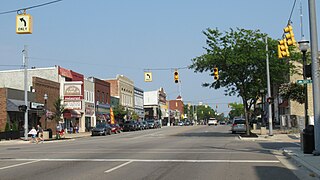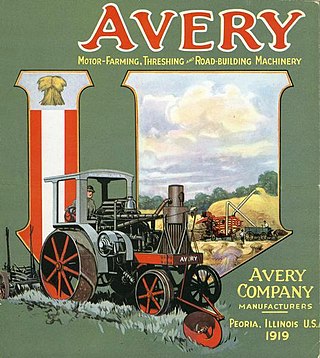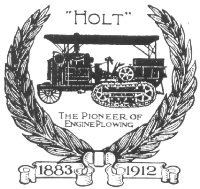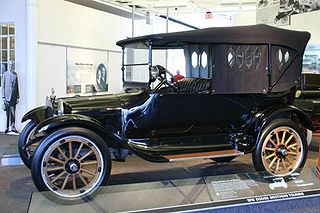
Ludington is a city in the U.S. state of Michigan. It is the county seat and the largest city in Mason County. The population was 7,655 at the 2020 census.

A tractor is an engineering vehicle specifically designed to deliver a high tractive effort at slow speeds, for the purposes of hauling a trailer or machinery such as that used in agriculture, mining or construction. Most commonly, the term is used to describe a farm vehicle that provides the power and traction to mechanize agricultural tasks, especially tillage, and now many more. Agricultural implements may be towed behind or mounted on the tractor, and the tractor may also provide a source of power if the implement is mechanised.

The Ford Model T is an automobile that was produced by the Ford Motor Company from October 1, 1908, to May 26, 1927. It is generally regarded as the first mass-affordable automobile, which made car travel available to middle-class Americans. The relatively low price was partly the result of Ford's efficient fabrication, including assembly line production instead of individual handcrafting. The savings from mass production allowed the price to decline from $780 in 1910 to $290 in 1924. It was mainly designed by three engineers, Joseph A. Galamb, Eugene Farkas, and Childe Harold Wills. The Model T was colloquially known as the "Tin Lizzie".

Alldays & Onions was an English engineering business and an early automobile manufacturer based at Great Western Works and Matchless Works, Small Heath, Birmingham. It manufactured cars from 1898 to 1918. The cars were sold under the Alldays & Onions name. Alldays also built an early British built tractor, the Alldays General Purpose Tractor. After the First World War the cars were sold under the name Enfield Alldays. Car production seems to have ceased in the 1920s but the manufacture of many other items continued. The company became part of the Mitchell Cotts Group.

Fordson was a brand name of tractors and trucks. It was used on a range of mass-produced general-purpose tractors manufactured by Henry Ford & Son Inc from 1917 to 1920, by Ford Motor Company (U.S.) and Ford Motor Company Ltd (U.K.) from 1920 to 1928, and by Ford Motor Company Ltd (U.K.) alone from 1929 to 1964. The latter also later built trucks and vans under the Fordson brand.

Benjamin Leroy Holt was an American businessman and inventor who patented and manufactured the first practical crawler-type tread tractor. The continuous-type track is used for heavy agricultural and engineering vehicles to spread the weight over a large area to prevent the vehicle from sinking into soft ground. He founded with his brothers the Holt Manufacturing Company.

The Ford N-series tractors were a line of farm tractors produced by the Ford Motor Company between 1939 and 1952, spanning the 9N, 2N, and 8N models.

The Avery Company, founded by Robert Hanneman Avery, was an American farm tractor manufacturer famed for its undermounted engine which resembled a railroad engine more than a conventional farm steam engine. Avery founded the farm implement business after the Civil War. His company built a large line of products, including steam engines, beginning in 1891. The company started with a return flue design and later adapted the undermount style, including a bulldog design on the smokebox door. Their design was well received by farmers in central Illinois. They expanded their market nationwide and overseas until the 1920s, when they failed to innovate and the company faltered. They manufactured trucks for a period of time, and then automobiles. until they finally succumbed to an agricultural crisis and the Depression.
Muir Hill (Engineers) Ltd was a general engineering company based at Old Trafford, Manchester, England. It was established in the early 1920s and specialised in products to expand the use of the Fordson tractor, which in the pre-war days included sprung road wheels, bucket loaders, simple rail locomotives, and in particular in the 1930s they developed the dumper truck. Later they built high horse power tractors.

Two-wheel tractor or walking tractor are generic terms understood in the US and in parts of Europe to represent a single-axle tractor, which is a tractor with one axle, self-powered and self-propelled, which can pull and power various farm implements such as a trailer, cultivator or harrow, a plough, or various seeders and harvesters. The operator usually walks behind it or rides the implement being towed. Similar terms are mistakenly applied to the household rotary tiller or power tiller; although these may be wheeled and/or self-propelled, they are not tailored for towing implements. A two-wheeled tractor specializes in pulling any of numerous types of implements, whereas rotary tillers specialize in soil tillage with their dedicated digging tools. This article concerns two-wheeled tractors as distinguished from such tillers.
The Albaugh-Dover Co. was an American manufacturer of farm implements, tractors, and automobiles based in Chicago, Illinois.
The Austin was a brass era American automobile manufactured in Grand Rapids, Michigan from 1901 to 1921. The company, founded by James E. Austin and his son Walter Austin, built large, expensive and powerful touring cars with an unusual double cantilever rear spring arrangement placing the rear wheels behind the passenger compartment, for a longer wheelbase to improve rider comfort in an era of rough roads as well as a unique two-speed rear axle.
Cockshutt was a large agricultural machinery manufacturer, known as Cockshutt Farm Equipment Limited (1957–1962), based in Brantford, Ontario, Canada.

The Oliver Farm Equipment Company was an American farm equipment manufacturer from the 20th century. It was formed as a result of a 1929 merger of four companies: the American Seeding Machine Company of Richmond, Indiana; Oliver Chilled Plow Works of South Bend, Indiana; Hart-Parr Tractor Company of Charles City, Iowa; and Nichols and Shepard Company of Battle Creek, Michigan.
Roths Industries, Inc. (1945–1960) was a manufacturer of small garden tractors and other agricultural equipment founded by Herbert C. Roths in Alma, Michigan. The company manufactured Garden King Walking Tractors, BesRo Riding Tractors, and Till Ro Stalk Cutters.
The Central League was a minor league baseball league that operated sporadically in 1900, from 1903–1917, 1920–1922, 1926, 1928–1930, 1934, and 1948–1951. In 1926, the league merged mid-season with the Michigan State League and played under that name for the remainder of the season. The Central League later reformed in 1928.

The Holt Manufacturing Company began with the 1883 founding of Stockton Wheel Service in Stockton, California, United States. Benjamin Holt, later credited with patenting the first workable crawler ("caterpillar") tractor design, incorporated the Holt Manufacturing Company in 1892. Holt Manufacturing Company was the first company to successfully manufacture a continuous track tractor By the early 20th century, Holt Manufacturing Company was the leading manufacturer of combine harvesters in the US, and the leading California-based manufacturer of steam traction engines.

House of Flavors is a manufacturer and retailer of ice cream based in Ludington, Michigan. It started as a dairy business as part of a farm operation before 1930. In 1935 the business had become known as Miller's Dairy and started expanding the operation. By the 1940s they processed milk, buttermilk, cottage cheese, and ice cream. In the late 1940s a businessman with a decade of dairy experience moved to Ludington from a city 60 miles south to become a partner of the existing business. He became the general manager and the name was changed to Park Dairy. The milk and butter segments of the business were sold off and the enterprise thereafter concentrated on just making ice cream.

The Dodge 30-35 was the first car produced by Dodge, introduced on November 14, 1914 and manufactured in Detroit, Michigan.

The Haskelite Building, also known as the Haskell Manufacturing Company Building, is a former factory building located at 801 N. Rowe Street, Ludington, Mason County, Michigan. The building was added to the National Register of Historic Places on November 10, 2022. In 2022, the building was refurbished into residential apartments, known as the Lofts on Rowe.














